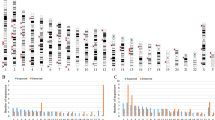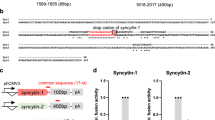Abstract
HERV-M (human endogenous retrovirus M), related to the super family of HERV-K, has a methionine (M) tRNA primer-binding site, and is located within the periphilin gene on human chromosome 12q12. HERV-M has been integrated into the periphilin gene as the truncated form, 5′LTR-gag-pol-3′LTR. Polymerase chain reaction (PCR) and reverse transcription-polymerase chain reaction (RT-PCR) approaches were conducted to investigate its evolutionary origins. Interestingly, the insertion of retroelements in a common ancestor genome can make different transcript variants in different species. In the case of the periphilin gene, human (10 variants) and mouse (2 variants) lineages show different transcript variants. Insertion of HERV-M (variant 1-3) could affect the protein-coding region. Also, Alusq/x (variant 4-9) and L1ME4a (mammalian-wide subfamilies of LINE-1) (variant 10) in humans and SINE (short interspersed repetitive element) and RLTR15 (the mouse putative long terminal repeat) (variant 2) in mice could be driving forces in transcript diversification of the periphilin gene during mammalian evolution. The HERV-M derived transcripts (variant 1-3) were expressed in different human tissues, whereas they were not detected in crab-eating monkey and squirrel monkey tissues by RT-PCR amplification. Taken together, HERV-M seems to have been integrated into our common ancestor genome after the divergence of simians and prosimians, and then was actively expressed during hominoid evolution.







Similar content being viewed by others
References
Altschul SF, Madden TL, Schaffer AA, Zhang J, Zhang W, Miller W, Lipman DL (1997) Gapped Blast and PSI-BLAST: a new generation of protein database search program. Nucleic Acids Res 25:3389–3402
Baban S, Freeman JD, Mager DL (1996) Transcripts from a novel human KRAB zinc finger gene contain spliced Alu and endogenous retroviral segments. Genomics 33:463–472
Bateman A, Coin L, Durbin R, Finn RD, Hollich V, Griffiths-Jones S, Khanna A, Marshall M, Moxon S, Sonnhammer EL, Studholme DJ, Yeats C, Eddy SR (2004) The Pfam protein families database. Nucleic Acids Res 32:D138–D141
Bieche I, Laurent A, Laurendeau I, Duret L, Giovangrandi Y, Frendo JL, Olivi M, Fausser JL, Evain-Brion D, Vidaud M (2003) Placenta-specific INSL4 expression is mediated by a human endogenous retrovirus element. Biol Reprod 68:1422–1429
Dunn CA, Medstrand P, Mager DL (2003) An endogenous retroviral long terminal repeat is the dominant promoter for human beta1,3-galactosyltransferase 5 in the colon. Proc Natl Acad Sci USA 100:12841–12846
Garson JA, Tuke PW, Giraud P, Paranhos-Baccaia G, Perron P (1998) Detection of virione-associated MSRV-RNA in serum of patients with multiple sclerosis. Lancet 351:33
Huh JW, Hong KW, Yi JM, Kim TH, Takenaka O, Lee WH, Kim HS (2003) Molecular phylogeny and evolution of the human endogenous retrovirus HERV-W LTR family in hominoid primates. Mol Cells 15:122–126
International Human Genome Sequencing Consortium (2001) Initial sequencing and analysis of the human genome. Nature 409:860–921
Jamain S, Girondot M, Leroy P, Clergue M, Quach H, Fellous M, Bourgeron T (2001) Transduction of the human gene FAM8A1 by endogenous retrovirus during primate evolution. Genomics 78:38–45
Jurka J (2000) Repbase update: a database and an electronic journal of repetitive elements. Trends Genet 16:418–420
Kazerounian S, Aho S (2003) Characterization of periphilin, a widespread, highly insoluble nuclear protein and potential constituent of the keratinocyte cornified envelope. J Biol Chem 278:36707–36717
Kim HS, Takenaka O, Crow TJ (1999) Isolation and phylogeny of endogenous retrovirus sequences belonging to the HERV-W family in primates. J Gen Virol 80:2613–2619
Kim TH, Jeon YJ, Yi JM, Kim DS, Huh JW, Hur CG, Kim HS (2004) The distribution and expression of HERV families in the human genome. Mol Cells 18:87–93
Landry JR, Rouhi A, Medstrand P, Mager DL (2002) The Opitz syndrome gene Mid1 is transcribed from a human endogenous retroviral promoter. Mol Biol Evol 19:1934–1942
Landry JR, Mager DL (2003) Functional analysis of the endogenous retroviral promoter of the human endothelin B receptor gene. J Virol 77:7459–7466
Lavie L, Medstrand P, Schempp W, Meese E, Mayer J (2004) Human endogenous retrovirus family HERV-K(HML-5): status, evolution, and reconstruction of an ancient betaretrovirus in the human genome. J Virol 78:8788–8798
Li WH, Wu Ci, Luo CC (1985) A new method for estimating synonymous and nonsynonymous rates of nucleotide substitution considering the relative likelihood of nucleotide and codon changes. Mol Biol Evol 2:150–174
Lower R, Lower J, Kurth R (1996) The viruses in all of us: characteristics and biological significance of human endogenous retrovirus sequences. Proc Natl Acad Sci USA 93:5177–5184
Medstrand P, Landry JR, Mager DL (2001) Long terminal repeats are used as alternative promoters for the endothelin B receptor and apolipoprotein C-I genes in humans. J Biol Chem 276:1896–1903
Mi S, Lee X, Li X, Veldman GM, Finnerty H, Racie L, LaVallie E, Tang XY, Edouard P, Howes S, Keith JC, McCoy M (2000) Syncytin is a captive retroviral envelope protein involved in human placental morphogenesis. Nature 403:785–789
Perron H, Garson JA, Bedin F, Beseme F, Paranhos-Baccala G, Komurian-Pradel F, Mallet F, Tuke PW, Voisset C, Blond JL, Lalande B, Seigneurin JM, Mandrand B, the collaborative research group on MS (1997) Molecular identification of a novel retrovirus repeatedly isolated from patients with multiple sclerosis. Proc Natl Acad Sci USA 94:7583–7588
Ruda VM, Akopov SB, Trubetskoy DO, Manuylov NL, Vetchinova AS, Zavalova LL, Nikolaev LG, Sverdlov ED (2004) Tissue specificity of enhancer and promoter activities of a HERV-K(HML-2) LTR. Virus Res 104:11–16
Sverdlov ED (2000) Retroviruses and primate evolution. Bioessays 22:161–171
Thompson JD, Higgins DG, Gibson TJ (1994) CLUSTAL W: Improving the sensitivity of progressive multiple sequence alignment through sequence weighting, position-specific gap penalties and weight matrix choice. Nucleic Acids Res 22:4673–4680
Tristem M (2000) Identification and characterization of novel human endogenous retrovirus families by phylogenetic screening of the human genome mapping project database. J Virol 74:3715–3730
van de Lagemaat LN, Landry JR, Mager DL, Medstrand P (2003) Transposable elements in mammals promote regulatory variation and diversification of genes with specialized functions. Trends Genet 19:530–536
Varmus HE (1982) Form and function of retroviral proviruses. Science 216:812–820
Yi JM, Kim HM, Kim HS (2004a) Expression of the human endogenous retrovirus HERV-W family in various human tissues and cancer cells. J Gen Virol 85:1203–1210
Yi JM, Kim HS (2004) Expression analysis of endogenous retroviral elements belonging to the HERV-F family from human tissues and cancer cells. Cancer Lett 211:89–96
Yi JM, Kim TH, Huh JW, Park KS, Jang SB, Kim HM, Kim HS (2004b) Human endogenous retroviral elements belonging to the HERV-S family from human tissues, cancer cells, and primates: expression, structure, phylogeny and evolution. Gene 342:283–292
Acknowledgments
We would like to express special gratitude to Prof. Timothy J. Crow, Warneford Hospital, University of Oxford, for his valuable English-language revision of the manuscript. This research was supported by a grant from the KRIBB Research Initiative Program.
Author information
Authors and Affiliations
Corresponding author
Additional information
[Reviewing Editor: Dr. Martin Kreitman]
Rights and permissions
About this article
Cite this article
Huh, JW., Kim, TH., Yi, JM. et al. Molecular Evolution of the Periphilin Gene in Relation to Human Endogenous Retrovirus M Element. J Mol Evol 62, 730–737 (2006). https://doi.org/10.1007/s00239-005-0109-0
Received:
Accepted:
Published:
Issue Date:
DOI: https://doi.org/10.1007/s00239-005-0109-0




